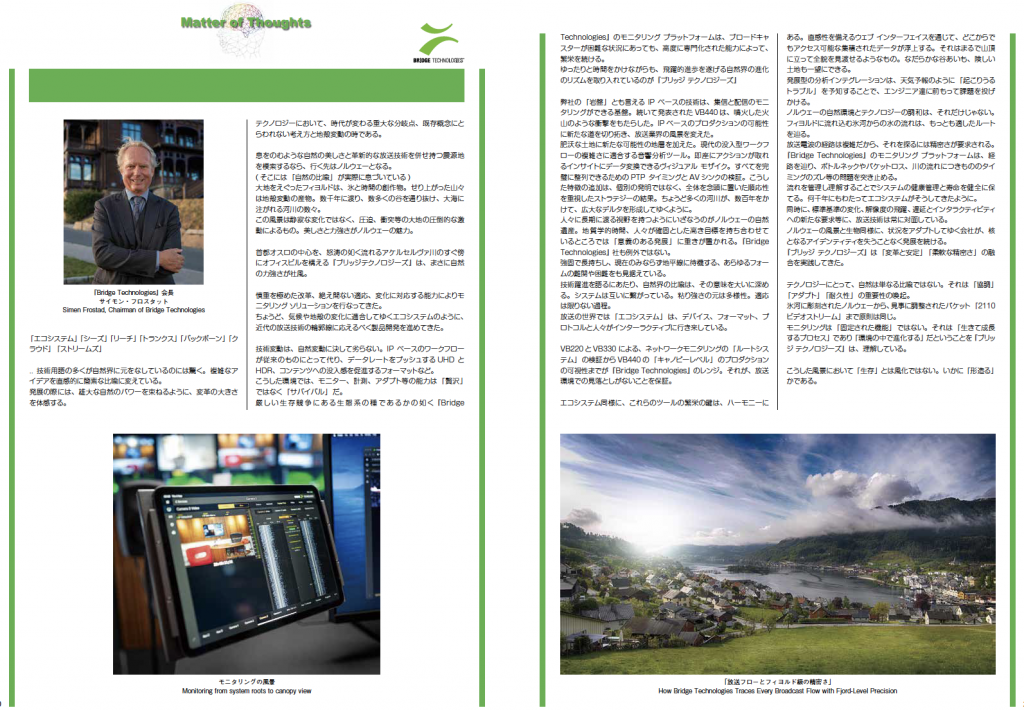How Bridge Technologies Traces Every Broadcast Flow with Fjord-Level Precision
November 13, 2025
As seen in TVTechnology Japan_ August 2025
Monitoring from system roots to canopy view
It’s amazing how much technological terminology borrows from the natural world – ecosystems, seeds and leeches, trunks and backbones, clouds, streams… The list goes on. They provide a simple visual metaphor that communicates complex ideas in a manner which is almost intuitive. And when it comes to progress, we harness the profound power and scale of nature to communicate just how big the changes we’re making are: we talk about watershed moments, evolving technological landscapes, blue-sky thinking, and seismic shifts.
If you’re looking for both a land of stunning natural beauty and the epicentre of ground-breaking broadcast technology (there’s those nature metaphors creeping in again…) you needn’t look much further than Norway. Here, fjords cut deep into the land, carved by ice and time. Mountains rise where tectonic plates once collided. Rivers thread their way to the sea through valleys smoothly polished over millennia. This landscape is not static; it is the product of countless converging forces – pressure, time, shifting conditions, and moments of upheaval – that have created something both beautiful and resilient.
Bridge Technologies – born in the heart of Oslo next to the raging Akerselva river – has taken inspiration directly from its natural surroundings. They have shaped their monitoring solutions through careful evolution, constant adaptation, and the ability to thrive in a changing environment.

Indeed, just as ecosystems adapt to climate and geography, Bridge’s products have grown in response to the contours of modern broadcast. The technological landscape is no less dynamic than the natural one: IP-based workflows replacing legacy systems, UHD and HDR pushing data rates, immersive formats reshaping how we experience content. In this environment, the ability to monitor, measure, and adapt isn’t a luxury – it’s survival. Bridge’s monitoring platforms, much like a species in a competitive biome, have developed highly specialised capabilities that allow broadcasters to flourish even in challenging conditions.
Bridge’s development path has followed the same slow-build, breakthrough-moment rhythm found in natural evolution. First came Bridge’s ‘bedrock’ of IP-based expertise, setting a base from which the industry could monitor contribution and distribution. Then came the VB440. When it was first released, it erupted like a volcano onto the scene – changing the shape of the broadcast landscape and carving out new paths of IP-based production potential. Slowly, a layering of new capabilities came upon this fertile ground: audio analysis tools that match the complexity of modern immersive workflows; visual mosaics that turn data into immediate, actionable insight; PTP timing and AV sync verification to keep everything in perfect alignment. Each feature addition was not an isolated invention but part of a larger adaptive strategy – much as a river delta expands over centuries, each new channel building on the pathways carved before it.
Norway’s natural heritage also has a way of making people think long-term. In a country where landscapes are measured in geological time, the idea of steady, purposeful progress is ingrained. Bridge has approached its technology in much the same way – designing monitoring solutions that are robust, enduring, and flexible enough to withstand not just today’s broadcast challenges, but those still forming on the horizon.
Nature’s metaphors run deep in the way we talk about technology for good reason: they remind us that systems are interconnected, that resilience comes from diversity, and that adaptation is constant. In the broadcast world, the ‘ecosystem’ is built from devices, formats, protocols, and people, all interacting. Bridge’s range – from the VB220 and VB330 probes that form the ‘root system’ of network monitoring, to the VB440 at the ‘canopy level’ of production visibility – ensures that no layer of the broadcast environment is left unobserved.

And like any thriving ecosystem, these tools work in harmony. The data they gather is surfaced through intuitive web interfaces accessible from anywhere – a feature that feels like standing on a mountain summit and being able to see the entire valley below, spotting both opportunities and hazards in real time. The integration of advanced analytics acts like a weather system forecast, predicting potential disruptions before they happen and giving engineers the chance to act early.
And the congruence between Norway’s natural environment and its technological one doesn’t end there. In Norway’s fjords, water finds the most efficient path from glacier to sea. In broadcast, signal paths can be just as intricate, and the need to trace them with precision is equally vital. Bridge’s monitoring platforms follow these flows, detecting bottlenecks, packet loss, and timing issues with the same inevitability that a river finds its course. Over time, this ability to track and understand the flow ensures the system’s health and longevity – just as balanced ecosystems sustain themselves over centuries.
But of course, broadcast technology will continue to face its own environmental changes – shifts in standards, leaps in resolution, new demands for latency and interactivity. The companies that endure will be those that, like the species and landscapes of Norway, can adapt without losing their core identity. Bridge Technologies has shown that the key is to pair innovation with stability, and precision with flexibility.
In the end, nature isn’t just a source of metaphor for technology, it’s a reminder of how to build it: interconnected, adaptive, and resilient. From the glacially-carved valleys of Norway to the finely-tuned packets of a 2110 video stream, the principles are the same. Bridge Technologies understands that monitoring is not a static function but a living process – one that must evolve in step with the environment it serves. In this landscape, survival isn’t just about weathering change. It’s about shaping it.
Visit us atInterBEE, together with our partners at Network Electronics Japan (Booth 3205, Hall 3)